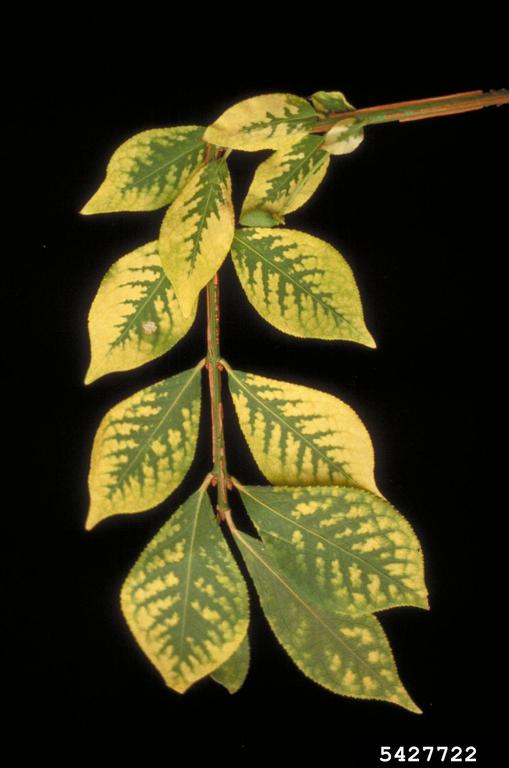 Recognizing and Treating Iron Deficiency - May 13, 2015 Jeff Schalau, Agent, Agriculture & Natural Resources University of Arizona Cooperative Extension, Yavapai County Iron deficiency is common on certain landscape and crop plants in the Verde Valley. The most noticeable symptom of iron deficiency is interveinal chlorosis: a yellow leaf with dark green veins. This is usually most evident on the newest leaves as they begin to grow in spring. In the extreme cases, the entire leaf may turn yellow or white and these areas can scorch and turn brown as the plant cells die. In the Verde Valley, the symptoms are most severe on the new growth of Photinia shrubs in areas where limestone or gypsum are plentiful and/or the topsoil has been displaced during construction. Many factors regulate iron availability and contribute to the complexity of iron chemistry in soil. Iron chlorosis frequently occurs in alkaline soils (pH > 7.5) and where lime (calcium carbonate) is plentiful. This condition describes much of the Verde Valley and many parts of Arizona. Most soils contain abundant levels of iron. However, this iron is not available to plants because iron forms insoluble compounds under alkaline soil conditions. This iron will remain relatively unavailable unless soil conditions are modified to lower the soil pH. Fertilizers with available forms of iron can also be used. Cool soil temperatures and conditions that restrict air movement into soil seem to also increase the potential for iron chlorosis. Where chlorosis symptoms are mild to moderate, symptoms tend to become less apparent and leaves “green up” as soils warm during the summer months. However, where iron chlorosis is severe, plants may go into permanent decline and never completely recover unless treated with an appropriate iron fertilizer. This sounds easy, but it can be expensive and labor intensive – especially if it occurs every year. Most horticulturists would agree that the best solution is to select plant species and cultivars that are adapted to alkaline soils and low iron availability. In practicality, it may not fit your budget or landscape goals to convert your entire yard to native and drought adapted plants. So, what else can be done? First, test the soil pH and investigate the area for gopher activity or other root disturbance in the area where symptoms are evident. Soil pH testing is available at no cost in either of the University of Arizona Extension offices in Yavapai County (see the Master Gardener contact information below). Next, assess the situation. Are the iron deficiency symptoms severe or mild? Do you have native topsoil? Is there evidence of compaction or poor drainage? Is there plastic sheet mulch preventing soil oxygen exchange? If so, consider which of these factors can be practically mitigated and which you might not be able to change. Changing entire soil layers is impractical but removing plastic mulches is something that will have other plant health and environmental benefits. Sometimes poorly performing plants should be removed to make way for tougher, alkaline adapted plants. For instance, Arizona rosewood (Vauquelinia californica) is an excellent replacement for Photinia. If the soil pH is 8.0 or above, then consider applying an iron fertilizer. The most common approach in established landscapes is to apply chelated iron or ferrous (iron) sulfate to the foliage. This treatment should improve the visible symptoms within a few weeks, but will need to be repeated each year. Another approach on established landscape plants is boring several one or two inch wide by one foot deep holes in the soil at the drip line of the tree or shrub and fill them a mixture of equal parts ferrous sulfate and elemental sulfur. This treatment is slower to alleviate symptoms but has produce longer lasting results and is less expensive (see the Utah State University reference below). If iron deficiency has been an ongoing problem in flowerbeds or vegetable gardens, then periodic additions of soil sulfur may alleviate the problem by temporarily lowering the soil pH making the iron present more available. Trunk injections are generally not recommended because a wound is created in the tree and this could create other, more serious problems such as butt and trunk rots caused by fungal infections. Finally, one treatment may work well in one area but not in another due to variations in soil conditions and species susceptibility. Keep records of what you did and what worked. See below for a photo and links to additional resources. Follow the Backyard Gardener on Twitter – use the link on the BYG website. If you have other gardening questions, call the Master Gardener help line in the Camp Verde office at 928-554-8999 Ext. 3 or e-mail us at verdevalleymg@gmail.com and be sure to include your name, address and phone number. Find past Backyard Gardener columns or provide feedback at the Backyard Gardener web site: http://cals.arizona.edu/yavapai/anr/hort/byg/. Additional Resources  Iron deficiency symptoms on Euonymous (Cheryl Kaiser, University of Kentucky, Bugwood.org). Recognizing and Treating Iron Deficiency in the Home Yard University of Arizona Cooperative Extension extension.arizona.edu/sites/extension.arizona.edu/files/pubs/az1415.pdf Control of Iron Chlorosis in Ornamental and Crop Plants Utah State University Extension extension.usu.edu/htm/publications/file=6275 |